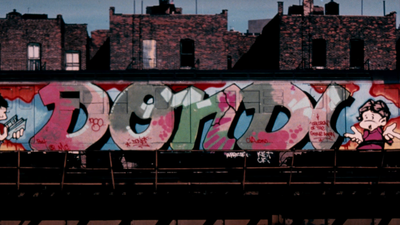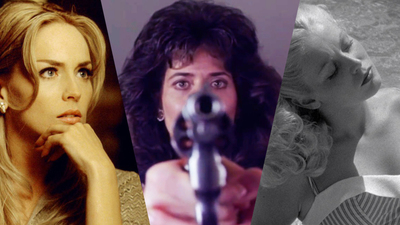
BY MARIAH PHILLIPS |
‘Girlhood’ Director Celine Sciamma Talks Paris, Friendship, and Colorful Storytelling
French director Céline Sciamma is known for her groundbreaking and controversial films. Last year her third feature, 'Girlhood' opened the Cannes Film Festival. On the occasion of her New York premiere, we sat down with the filmmaker to discuss the coming of age film.
Tribeca: How would you describe Girlhood to someone who hasn’t seen the trailer?
Céline Sciamma: I would say it’s a coming of age story, with this eternal feel of a girl wanting to become herself. This is a classical tale, but with a very contemporary character and it’s a tribute to friendship.
T: A lot of the scenes are very familiar to anyone who has spent time in Paris, and a lot of the scenes were very familiar to me, but I realized that I was also experiencing them as an outsider. How did you approach this film, knowing that you, too, were an outsider?
CS: Well, that was actually the program, to not think of those characters or those places as a strange world, or another world that I should try to understand as something exotic. I really wanted to look at it as a strong fiction, and to build characters and not to take the bias of a sociological point of view, but really to make a Romanesque gesture. I grew up in the suburbs of Paris. Not a hard suburb, but a very mixed one. So it’s a really intimate place for me. All my movies are set in the suburbs so far, and so it’s a very intimate place. At least, that’s the feeling I get from it. I rely a lot on that feeling, and the fact that you are so close to the center, and yet, so far away. You are really at the periphery. You feel [like you’re] at the margin or something. Those concepts are really something I try to put into the narrative. Then, of course, I did a very long casting and I met 300 girls, and it definitely made it into the plot, you know—who did what, where, and what they were telling me, and their different energies—and I tried to document that, in a way. So, it’s a big mix.
I liked the fact that it was also blurring the territory of the cinema.
T: Speaking of the actresses, why do you like working with “unknown” actors and actresses?
CS: I think it’s the last time that I’m going to do it actually. Now that I know that I want something else, I can figure out better why I liked it so much. First, I’m not obsessed with the fact that they are non-professionals or newcomers. I’m obsessed with the fact that they need to be young. I really don’t want to cast 25 [year olds] to play 16. It’s something that happens a lot, and so that got me into that non-professional work, but I think that I was quite young when I made my first film. I was 27 or 26, and I think that working with non-professionals helped me figure out what kind of director I wanted to be, what my method would be, without destroying the hierarchy with actors. You know, the actors being more powerful than me or me more powerful than them. It’s really a youth thing. Also, you’re free. You’re really free. You can create your own prototype in the industry because you have no pressure of the star system and you can really build strong character and you can show new faces, which excites people a lot, I think with film. I think people get fed up with seeing the same thing. That really helped me, because I grew up with my characters and my actresses as a director.

T: I think it was really interesting that the only time that we see Vic in Paris proper is when she has to perform this very over sexualized idea of femininity. When did you make that decision, to make Paris stand for that, in a sense?
CS: Well, before that, when we do see Paris, it’s the subway. It’s Chatelet-Les Halles. It’s a stage. It’s a place where they perform, really. I really thought about the spaces like that. Public spaces are the spaces where they perform their act of playing themselves, better than themselves, and bigger than themselves. Whereas the neighborhood is where they have to follow the rules. The house is, too, because you have to share the space. The intimate place, they have to rent. It’s the hotel room. But you’re right. When we see Paris, as we expect it, with the buildings haussmannien, she is that “creature.” It’s also one of the only times we see white people in the film, really. We forgot they actually existed. I made that decision. That last part of the film is strange. You don’t expect it, and it’s a decision I made in the process of writing and putting the script together, because that last part is when everything is heads up. She’s very feminine in that costume, but she’s also “one of the boys,” and she mixes everything up. It’s a really important part of the film, because it’s the part that blurs everything but thinks a lot. She’s iconic in that first scene, in an iconic Paris. Once more it’s a performance. I think at that moment in the film, she’s the most high with those two performances of being a guy and being that iconic dealer. She’s at the climax of performing and not choosing anymore who she is, so that in the end, she can actually give up everything.
Blue allows me to slip from reality to fantasy.
T: Color is what stands out in my mind with all your films, but especially in this film. Immediately, I think of the color blue. Did you use any unconventional methods to really create those images that you saw in your head?
CS: There are different layers to create an image. Of course, we talk about the light, because that’s the work of the DP. To me, there’s the light, but then there’s the outfit—the costumes—and there’s the wall. I’ve been the costume designer of my films so far, and we work in synergy with the DP, the decorator, and the costumer designer that I am, to actually build those layers. All the interiors of the film are built; it’s a set, so that we can actually choose each color. The color of the curtain, the wall, and the lamp—it’s something that I’m actually quite obsessed about. The color blue can be on a shirt in a very naturalistic picture, to suddenly it’s in the whole room, like in the Rihanna scene. Blue allows me to slip from reality to fantasy. I think that’s the reason I use it, but it’s not very conscious. That’s the weird thing. Blue is everywhere in my films, and people keep asking me questions, and they’re right! Each time I go for it like it’s the first time. It’s like how I go everyday to the bakery and say, “Oh, I’m going to take that!” And it turns out it’s actually my favorite cake, but each time I say, “Uh, this one!” It’s weird. The movie, this time, is even more committed to being colorful, especially because those kinds of places and characters from the suburbs are often assigned one energy and one language. You know, as the character refuses the destiny they set for her, the movie also actually refuses the aesthetic destiny set for it. Let’s do cinema! Let’s be epic! Let’s believe in color! Let’s believe in music! Of my three movies, this is the one that actually goes farther in that direction.

T: What about this story really grabbed you?
CS: I think there were three things I wanted to work around. Friendship of a group, definitely, because so far, my films have been about duets or trios, but this time, I wanted to have that energy of the group, and to talk about friendship and how the group can actually be seen as a bad influence or as uniformity. I think it can enable you to find yourself. I wanted to talk about family and friends, sorority—how strong and how complex it is. I also wanted to talk about anger. Anger and violence. How violence is actually something you always give back. How physical violence is never questioned in the movies, because it’s always portrayed as good fighting evil. We see some horrific things, but we’re still thinking, “Yeah!” But when we see this in a social-realistic movie that someone is getting slapped, you think, “Oh, that’s not good.” I really wanted to talk about how a fight can be a struggle. Violence can be political for women. It can be empowering and shouldn’t be looked at as hysterical, but can speak about activism. Those were the kinds of things I was thinking about, and then I crafted the story really trying to make it the most universal, and thinking about how it would fit in the tale of a romantic heroine. I was trying to really make the romantic heroine of the 21st century. It’s finding the balance between all those things that I’m really obsessed about.
T: I know you mentioned that for your next project, you’re not necessarily going to work with “unknown” actors. What’s next?
CS: I think I still want to work around strong female characters and their social identities, but maybe in a more genre approach. I could definitely write a feminist horror movie, in another world or another time. I’m looking at something really different, but I don’t know yet. I’m still dreaming about it.

